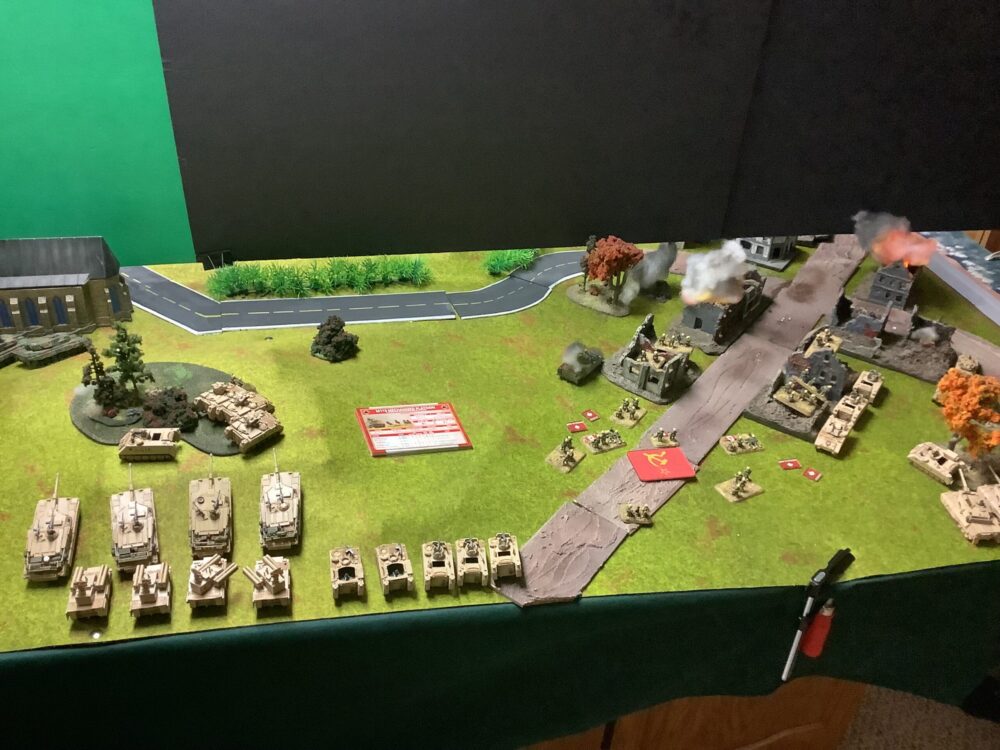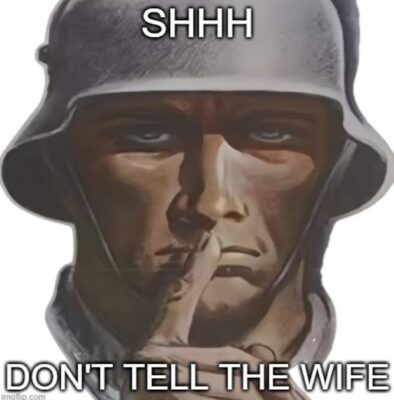
There is a small but dedicated group of retired military guys in Petawawa, Ontario, Canada who have been playing Team Yankee for a number of years now. Their names are Bob McBride, Lindsay Cameron and Louis Santerre. Being ex military they want rules to be as realistic as possible. So, they came up with some house rules that they feel play just a bit better than the standard Team Yankee rule set.
Here is what they came up with:
OFF BOARD ARTILLERY:
1. Heavy and medium artillery may be declared, at the beginning of the game, to be “Off Board”.
2. Any “Off Board” artillery is considered to have the range to engage any target on the board.
3. Counter Battery fire is permitted against your opponents “Off Board” artillery but it is assumed
the template is over “near terrain”; therefore, a penalty of +1 is added to any ranging-in (page
53). The target is assumed to be no more than 3 guns under a small template.
4. Once “Off Board” artillery has fired it is deemed to automatically “Shoot & Scoot” during the
assault phase and has moved, so it is no longer under the template; therefore, any future
counterbattery fire must be ranged once again.
5. Mortars may not be placed “Off Board” due to their limited range.
6. “Off Board” artillery may be engaged by close air support (CAS) but must range in with a +1
penalty as it is considered that the template is over near terrain. CAS Aircraft may be engaged
by AA if the range of the AD system can reach the edge of the board where the player’s
deployment originated from.
7. Any on board artillery has the ability to “shoot and scoot” IAW with the applicable “shoot and
scoot rule” and must take a skill test in order to move. (page 37).
8. The cost of any “Off Board” must be included in the players total point value; however, the
models themselves are not required unless the player intends to deploy them on the table.

DISMOUNTED SPECIALIST OBSERVER:
1. Observers cannot call for fire the turn they dismount but can attempt to dig-in as long as they
pass a “Blitz Move” and don’t move any further. An Observer can only dismount at the
beginning of its movement phase IAW the rules for mounting and dismounting. (page 34)
2. The Observers vehicle is subject to the transport rules as a dedicated transport. (page 35).
Should they remain on the table they must remain within command distance of each other.
3. An empty observer transport cannot call for fire but can direct fire its MG. It retains it scout rule
as an independent tank team.
4. Dismounted Observers are treated as independent infantry teams (with the characteristics of its
national origin) and retain the scout rule. (rate of fire 2 /anti-tank 1 / fire power 1)

HIDDEN SETUP:
1. A screen is setup such that players cannot see their opponent’s initial deployment. Anything
between a small gap at the bottom of the screen and the board can be seen and engaged.
Should shooting occur the screen is removed, normal sequence of play is triggered and the
player who shot first completes their turn.
2. Neither side can initially deploy within 12 inches of the screen
3. In subsequent turns movement can be conducted. A die is rolled on the first turn. On a score of
5+ the screen is removed. For each subsequent turn add an additional die.
4. Once the screen is removed, normal sequence of play is conducted.

The enemy side before deployment and after objective markers have been placed.

The friendly side of the table before deployment. Note the big screens with a small gap at the bottom. It really forces you to do a terrain study before deploying your troops.
DIRECT FIRE SMOKE: (page 50)
1. Teams capable of firing direct smoke (eg. Tank Teams) are not restricted by having to fire at a
specific opponent’s team.
2. They may fire at any point on the board within their range and line of sight.
3. Smoke must be fired first before any other shooting.
TANK TRANSPORT ATTACHMENTS:
1. Tank Transport Attachments: (page 19) both parts of the unit operate independently as
separate units, supporting each other, although they deploy as a separate unit. Supporting each
other is defined as; in proximity of each other. Proximity is defined as within 12 inches of an
affiliated infantry unit.
2. Unit Morale Checks: (page 64) If an infantry unit is destroyed or fails its morale check, its transport attachments, that have remained in proximity, are removed from the
game but are not considered destroyed. Regardless where the transport unit is located even if
they are no longer located in proximity of the affiliated infantry unit, they are removed but not
considered destroyed.
3. Victory Points: (page 83) Count separately core units from their attachments that have not
remained in proximity to each other. Under these circumstances if they are both destroyed they
count as two separate units. Two victory points are awarded to the opponent.

My OVERWATCH Rule Suggestion:
I also have a suggestion for an Overwatch rule. One thing that has always frustrated me with Team Yankee and Flames of War is how a unit can be dug in, gone to ground and have their weapons aimed and ranged into a certain piece of ground yet not get to shoot first. I don’t understand how a unit came come out of cover and advance towards me and get to fire first just because its their turn and my guys have to just take it even if tactically they did everything right. I would suggest that we try something like the Air Defence Rules. The only thing that might have to be different is that you just can’t shoot anywhere on the table. There would have to be some mechanic where you can only shoot along your centre of arc with a left and right amount in inches. We didn’t use this in the game, but I’d like if someone did some playtesting.
A little while ago the boys from Petawawa, which is home to our 2 Canadian Mechanized Brigade Group (2 CMBG) (Facebook), the Canadian Special Operations Regiment (CSOR) Canadian Special Operations Regiment – Canada.ca , 427 Special Operations Aviation Squadron with Griffon helicopters 427 Special Operations Aviation Squadron – Royal Canadian Air Force – Canada.ca and 450 Tactical Helicopter Squadron with Chinook helicopters 450 Tactical Helicopter Squadron – Royal Canadian Air Force – Canada.ca invited me to make the two hour drive for a game. They set up a 12 foot by 4 foot table and we played 2 v 2. My Canadians joined up with the Germans while we faced off against the Soviets.
I won’t be giving a detailed battle report but will discuss how the rules played out and my thoughts. First up is the Offboard Artillery Rule. This one probably excited me the most. Gone were the games where you put some guns on the table only to have them have to engage in an anti tank shoot with rapid fire tanks or reconnaissance vehicles. They could now concentrate on doing their job of providing indirect fire support. I figured there would be a big counter battery fire fight to start the game, but that didn’t happen, even though each player brought at least one unit of artillery. I guess we all just wanted to fire at the enemy troops directly in front of us. Perhaps if there was a turn of counter battery fire before the game starts, one would keep shooting at the other player’s guns until those guns were gone.
I was also looking forward to the Dismounted Observer Rule and I even painted up an observer stand. I put him in a nice hill feature, sent his M113 to the rear, dug him in and had him start doing his job of directing the guns onto targets. My opponents “targeted” him right away. Eventually they would roll a six and I’d roll a 1 or 2 as a save, they made Fire Power and after a couple of turns he was out of the game. Maybe a dismounted observer could get an extra modifier to keep him in the game longer. Or perhaps it was just that he became a priority target for the enemy. Either way, it was nice having the option of a dismounted or a mounted observer.
The Hidden Set Up is the biggest game changer (pardon the pun) here. It forces one to have recce elements in their army and to use them as they are designed. That is, to go ahead of the army and locate the enemy and to provide flank security so that there are no surprises. Once that first unit spots an enemy unit behind the screen all the screens are lifted. And there are usually some surprises to be had. Some bad luck or bad deployments could mean one side is in trouble early in the battle. In our game we made sure to cover all the most probably enemy approaches and got lucky in that the enemy wanted to use the approaches that we had prepared for. The Petawawa guys said that they liked playing this rule with from the short table edges as the units had more room to maneuver before being located. I’d like to try that in the next game I play. And perhaps on a much bigger table or with a smaller number of points.

My Canadians initial deployment. Recce right front and the infantry dug into the ruins to deny the Soviets an objective. They are supported by Leopard 1s in a hide. I have my TOW and ovserves in the woods on the hill to the left of the photo. My M1a1’s, ADATS, mortars and depth platoon are behind the large hill feature waiting to react to Soviets moves. Note the Germans on the left near the church.

The recce has done its job and the screens come up. I’m in perfect position to stop the Soviet threat on our right. They never got much closer than this.
The Direct Fire Smoke rule played out just as predicted. It wasn’t that much different than how the present rule. I didn’t take advantage of the Tank Transport Attachments rule. I’m sure the fact that I was fielding M113’s against BMP’s might have had something to do with it. I kept them close to the infantry to support them. My German ally on the other hand used his Marder 2’s to great effect with their firepower and mobility. They fought well in front of the infantry and kept their small infantry platoons safe from the enemy. You have to be careful though as losing the transport teams will cost you twice the victory points. My strategy would be to get some shots in and them withdraw them to support the infantry once they come under effective fire.
I hope this article inspires Team Yankee players to try some or all of these house rules and share their experiences with other players or in the comments below.
You may have noticed some Canadian vehicles in desert colours in this article. That is a teaser for my next article on my Desert Storm Canadians.

















